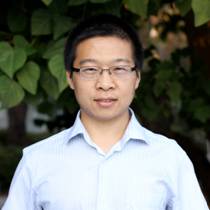|

|
Dr. Ying-Long Miao
Research Associate, McCammon Research Group
Howard Hughes Medical Institute
University of California, San Diego
Email: yimiao@ucsd.edu |
Abstract: G-protein coupled receptors (GPCRs) are important cell signaling proteins that have been targeted by ~1/3 of marketed drugs for treating many human diseases such as cancer and heart failure. While significant advances have been made in recent structural and computational studies, detail mechanisms of GPCR activation that occurs on the millisecond timescales remain unclear. The X-ray crystal structure of the M2 muscarinic receptor, a key GPCR that regulates the human heart rate and contractile forces of cardiomyocytes, was first determined in an antagonist-bound inactive state. Starting from the X-ray structure with antagonist removed, we captured activation of the apo M2 receptor through hundred-of-nanosecond accelerated molecular dynamics (aMD) simulations. The receptor activation is characterized by largescale structural rearrangements of the transmembrane helices via an intermediate state. With the simulation-derived activation-associated conformers, a fragment-based site mapping program FTMAP is applied to explore druggable allosteric binding sites in the M2 receptor. Virtual screening is then performed to select small-molecule drugs that bind these allosteric sites and modulate the receptor signaling. In contrast to highly conserved residues in the orthosteric site where the endogenous ligand binds, residues in the allosteric sites exhibit large diversity across different GPCR subtypes. Therefore, GPCR allosteric modulators are promising to provide highly selective therapeutics.
About the Speaker: Dr. Ying-Long Miao is a computational chemist and molecular biophysicist interested in the research of developing and applying theoretical and computational chemistry methods to study the dynamics and function of biological macromolecules and design novel small-molecule drugs. In close collaboration with biophysical and biochemical experimentalists, his current research efforts are directed towards understanding the functional mechanism of key biomolecules, particularly G-protein Coupled Receptors (GPCRs). Taking a highly interdisciplinary approach involving physics, chemistry and biology, the research aims at bridging the gap between fundamental research in theory of biomolecular dynamics and discovery of pharmaceutical drugs to address unmet biomedical needs in treating critical human diseases. Dr. Miao’s graduate research was focused on all-atom multiscale computational modeling of viral dynamics. He has been also experienced with combining neutron scattering, NMR and molecular dynamics simulation to investigate the dynamics of cytochrome P450cam, a model system of drug-processing protein enzymes.
Date&Time: March 20, 2014 (Thursday), 10:30 -11:30 a.m.
Location: 606 Conference Room


